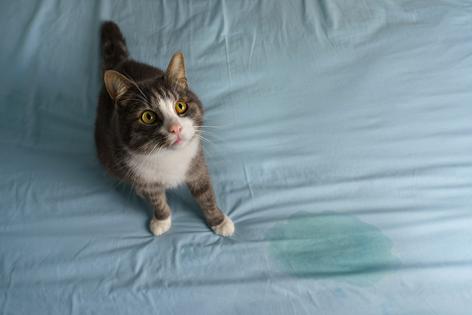My Pet World: Is your cat urinating in bed? Here are some reasons why
Dear Cathy,
I love cats dearly. Twice in the last 30 years, I have had a male and female from different litters when the female cat suddenly urinated in our bed. I always ended up giving one of the cats away. I learned my lesson and now have male cats only.
Would you please address this issue because now my friend has the same problem? They adopted a female cat from the shelter, then added a young male to the family. Almost immediately, the female cat began to urinate everywhere. Short of giving one of the cats away, what could she do?
Incidentally, my friend has three litter boxes, but her male marks all of them.
— Ingrid, Las Vegas, Nevada
Dear Ingrid,
I hope your friend’s first instinct is not to get rid of the female cat. Inappropriate elimination occurs in both sexes for many reasons, which can be dealt with by an owner committed to figuring out what is causing the problem.
Here’s why her cat may be doing it and what she can do to address it:
To begin, any change in a cat’s environment can result in inappropriate elimination, from adding a new cat, dog, or baby to the family to a family member working longer hours than usual. So, her female cat is most likely reacting to the new male cat. To help her adjust, tell your friend to introduce feline pheromone collars for both cats and plug-in pheromones for around the house. They don’t solve the problem but can provide a calmer environment as everyone adjusts.
Next, she needs to use an enzymatic cleaner to clean the mattress and then put on a mattress cover. Tell her to close the bedroom door to keep the cat off the mattress when she can’t supervise. She should start playing with her female cat on the bed, and giving her treats when doing so, so she learns to re-associate the bed with something positive.
Another reason for the inappropriate elimination may be litter box placement, the litter itself, or the male cat marking the boxes. She can sprinkle baking soda to freshen it up and add a litter attractant to lure her back to the box.
The litter boxes should be placed where the female cat will feel safe from an ambush by the other cat. At the same time, make sure the male cat is not blocking the female from using the litter boxes. If he is, he needs to be shooed away and redirected with play. Both cats should be fixed if they are not already.
While not as likely, she should still rule out a health problem with her veterinarian. Both male and female cats can have urinary infections, bladder stones, and cystitis, which are painful and cause many cats to eliminate in inappropriate places. But I am pretty sure her female cat is just stressed from the new cat in the house and needs some patience as she adjusts.
Dear Cathy,
My neighbor recently adopted a three-year-old male German Shepherd named Duke. I’m a neighbor who lives close by, is/was the pet sitter, and have visited Duke about three times. The poor thing seems nervous, paces all over the house, barks a lot, and when left alone, and seems very hyper even when in a crate (new to him) or trying to connect with an older unfriendly dog in the family.
My main concern is for myself: Upon me leaving his residence, Duke gets mad and gets closer to me, barking wildly and looking scary! The owners immediately put him in the crate or a bedroom until I’m gone. How can this dog be helped?
— Joyce, Connecticut
Dear Joyce,
Things may be moving too fast for this dog. The dog is fearful and anxious, and that is why he’s reacting this way. The family can’t let the dog scare and intimidate visitors to the home though.
They need to talk to a veterinarian, veterinary behaviorist, or animal behaviorist to assess the dog’s behavior and lay out a plan to help the dog adjust to his new home and get comfortable meeting new people. He should also attend obedience classes to expose him to new people in a safe setting.
During the training period, the family can introduce over-the-counter calming chews into his daily routine and a canine pheromone collar and/or canine pheromone plug-ins for around the house to tamp down his nervous energy. Until the dog makes progress, the dog should be placed in another room when there are visitors.
========
(Cathy M. Rosenthal is a longtime animal advocate, author, columnist and pet expert who has more than 25 years in the animal welfare field. Send your pet questions, stories and tips to cathy@petpundit.com. Please include your name, city, and state. You can follow her @cathymrosenthal.)
©2023 Tribune Content Agency, LLC.
(c) 2023 DISTRIBUTED BY TRIBUNE MEDIA SERVICES, INC.










